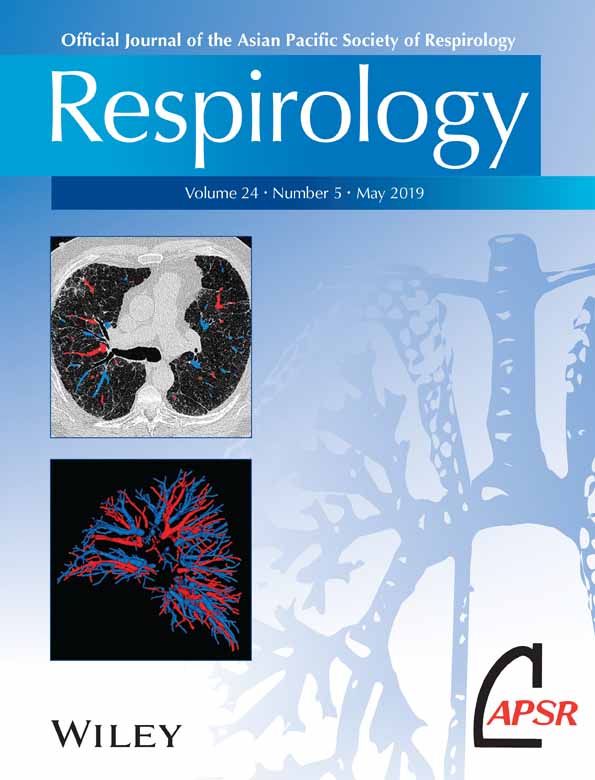Molecular breath analysis for IPF: Can we make a few breaths count?
Abstract
See related Article
Idiopathic pulmonary fibrosis (IPF) has a median mortality rate of 3–5 years after diagnosis.1, 2 It is characterized by the progressive destruction of lung parenchyma through repetitive alveolar injuries and accumulation of scar tissue.3 With the availability of two approved anti-fibrotic drugs, nintedanib and pirfenidone, an earlier diagnosis of IPF potentially improves long-term clinical outcomes of this ultimately fatal disease.4, 5 However, recognizing IPF in the early stage is quite challenging. Invasive surgical biopsies are required in cases where a confirmative diagnosis is impossible despite comprehensive multidisciplinary discussions. Furthermore, it is extremely difficult, if not impossible, to predict disease progression for individual patients with current means. For these reasons, non-invasive biomarkers and novel analytical methods would be very useful. Most biomarker studies in IPF focus on the analysis of peripheral blood and bronchoalveolar lavage fluid (BALF) or lung tissue.6, 7 Some of these have shown promise, but as of yet, none of them have developed into an applicable tool for the management of IPF patients.
Exhaled breath condensate (EBC) is an attractive medium for biomarker studies, particularly for airways disease, acute alveolar injury and pneumonia. The best chemical or biochemical substances measurable by EBC by far are small molecular and volatile substances, such as NO.8 In the current issue of Respirology, Gaugg et al.9 present a novel way to analyse exhaled breath from patients with IPF and found increases in amino acids suggestive of scar formation. They used a method called secondary electrospray ionization-mass spectrometry (SESI-MS), a type of MS that has high sensitivity, to analyse a variety of vaporous samples at ambient pressure. Prior to this study, these investigators analysed EBC with the same methodology in patients with chronic obstructive pulmonary disease (COPD) and asthma and found several chemical families that changed significantly after inhalation of salbutamol but not after placebo.10 The authors propose that the elevated levels of proline, 4-hydroxyproline, alanine, valine, leucine/isoleucine and allysine in the EBC of IPF patients are consistent with previous reports showing increased levels of some of these amino acids in IPF lung tissues analysed by gas chromatography-MS.11 While this argument seems plausible, the authors did not show a direct correlation between EBC and lung tissues in their own study. It is correct that human collagens have abundant proline and 4-hydroxyproline, and elastin fibres contain plenty of proline, alanine, valine and leucine/isoleucine. It is also correct that the turnover of collagens and elastins is significantly altered in IPF lung tissues. The authors also calculated the remarkable ability of this analytical method to discriminate between IPF patients and controls. Interestingly, there were no or only weak correlations between lung function and EBC amino acid levels; these results, in turn, imply the potential for this approach to become a screening tool of early-stage IPF.
What are the goodies in this paper other than describing increases in amino acids using a novel analytical method? It is a well-conducted pilot study showing feasibility of collecting EBC in patients with IPF. In contrast to the majority of EBC studies, they used a different procedure to collect the samples. Most studies require patients to breathe for 10 min at tidal volume, which can be a challenge for IPF patients, especially when their forced vital capacity (FVC) decreases with progression of disease. In the Gaugg et al. study, patients did not need that many breaths to make it count: they delivered only 4–6 consecutive full exhalations through a disposable mouth piece with a steady pressure. This, presumably, would be preferred by patients compared to breathing the full 10 min through a mouthpiece.
However, there are some limitations, most of them openly acknowledged by the authors. One major issue is the specificity of the altered amino acid levels in EBC. Proline, alanine, valine and leucine/isoleucine are certainly key constituents of collagen and elastin, but these amino acids, just as the scars they make, will also be present in the tissues and EBC of other fibrotic lung diseases such as collagen-vascular disease, interstitial lung disease or chronic hypersensitivity pneumonitis. Other chronic lung diseases such as COPD and asthma show significant bronchial fibrosis and may also demonstrate increases in these amino acids. Healthy controls are a good start, but the discriminatory power of a test against this group is diagnostically not relevant for a clinician. Furthermore, the authors excluded patients who had liver or renal disease. These common comorbidities of IPF alter the levels of numerous proteins in serum, which may also change amino acid levels in EBC. In addition, from a biochemical perspective, we cannot ignore that collagens and elastins are not the only matrix molecules that are altered in IPF lung tissue. In fact, glycosaminoglycans are even more altered in fibrotic lungs,12, 13 and the changes in EBC amino sugars may be more reflective of these molecules.
Another important shortcoming is that the effect of anti-fibrotic therapies on the EBC levels of amino acids was not properly studied. Indeed, exploring dynamic changes over time before and after initiating anti-fibrotic drugs would be much more interesting compared to using this tool to establish a diagnosis. Here is the real potential for a meaningful clinical impact of this analytical method. Given the relative ease of obtaining EBC-form IPF patients, one would hope that Gaugg et al. are already conducting such a longitudinal study.
Regardless of these limitations, we should embrace the findings as they opened the door to a new quest for a potentially useful biomarker for IPF. They showed that obtaining enough EBC for a detailed analysis of metabolites of matrix turnover is (i) doable, (ii) relatively quick, (iii) non-invasive and therefore (iv) repeatable over time, and (v) investigating amino acids is based on a plausible biological and biochemical foundation. As we said earlier: make the breaths of your patients count and explore whether matrix metabolites change over time and respond to anti-fibrotic medicines!




